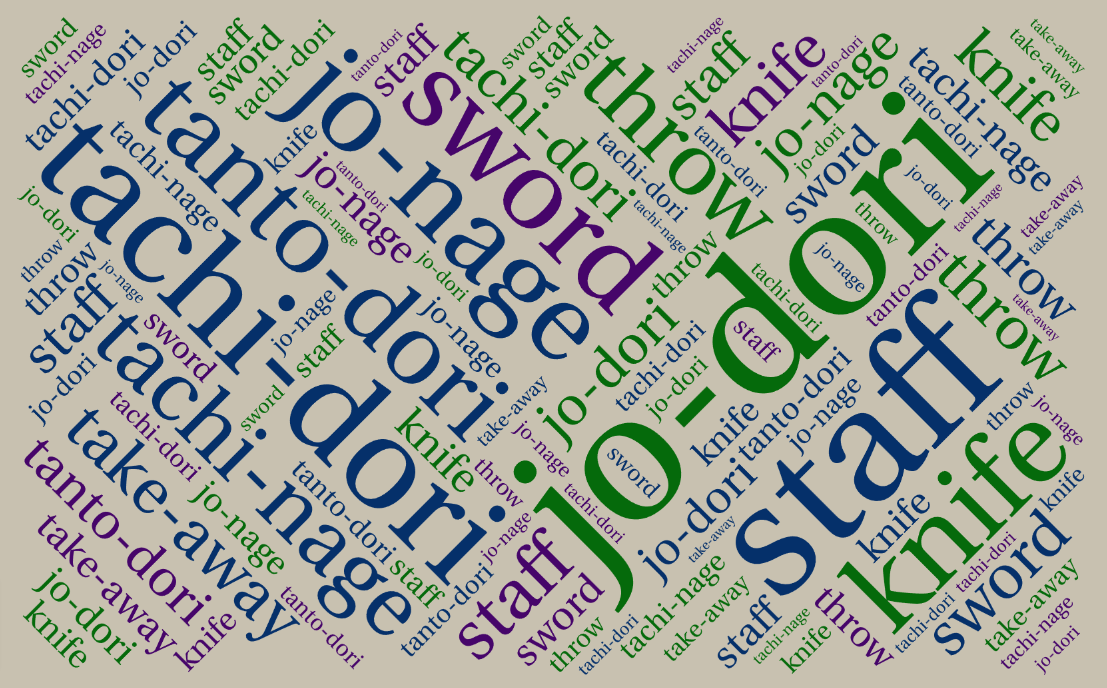The names for weapons take-aways in Aikido can be perplexing. The take-aways, or -dori, are easily confused with another set of techniques, throws, which end in -nage. Let’s see what they are, and how they are different.
A friend is preparing for a kyu exam and asked about some techniques listed in her exam requirements. She is to demonstrate three jo-dori and three tachi-dori. But what are those? And what are jo-nage and tachi-nage? Turns out she’s done them before, she just wasn’t familiar with the names.
All these Aikido techniques involve one of the partners having a weapon.
This is one in my collection of articles about Japanese words in Aikido. Here is an introduction to those articles, which might be a good place to start if you haven’t read it yet.
Taking Away an Attacker’s Weapon: “-Dori“
Jo-dori and tachi-dori are often called weapons take-aways. You’ll also see tanto-dori. Each is a whole bunch of techniques. Most of them will be related to empty-hand techniques, like ikkyo, shiho-nage, kokyu-nage, kokyu-ho, etc., so the forms and names will be familiar.
In the “-dori” techniques, Uke has a jo, bokken, or tanto, and attacks you with it. You are usually empty-handed. You grab their weapon and throw them or pin them, taking their weapon away.
- Jo-dori are jo (staff) take-aways.
- Tachi-dori are bokken (or sword) take-aways.
- Tanto-dori are tanto (knife) take-aways.
The “dori” part means grabbing or grasping — more literally, seizing — the same as when we grab someone’s wrist (katate-dori) or shoulder (kata-dori). Sometimes they are written with a hyphen (“jo-dori”) and sometimes not (“jo dori”). Either is fine. You should follow the convention used at your own dojo.
Throwing Someone With Your Own Weapon: “-Nage“
The other set of words you’ll hear, which are similar-sounding, are jo-nage and tachi-nage.
In the “-nage” techniques, you have a weapon, but Uke doesn’t. Uke tries to take your weapon from you. You keep your weapon, and use it, along with your arms and hands, to throw or pin them.
- Jo-nage are where you keep your jo (staff).
- Tachi-nage are where you keep your bokken (or sword).
- Tanto-nage would be where you keep your tanto (knife). There’s no reason one couldn’t do tanto-nage, but I can’t think of a time I’ve seen them taught or demonstrated.)
The “nage” part means throwing, the same as when you do kokyu-nage or shiho-nage without weapons.
Shouldn’t They Be Ken Dori and Ken Nage?
Good question. No. “Tachi” is another way of saying sword. While we often use “ken” (bokken, ken suburi, ken tai jo, …), for some reason in this context we use “tachi.” I have no idea why.
Wait, What About Tachi Waza? Sword Techniques, right?
Good guess, but strangely, no. The “tachi” in tachi waza means standing. Tachi waza are standing techniques, as opposed to suwari waza, which are done from a seated position, on one’s knees and toes.
Got It?
In the jo-dori, tachi-dori, and tanto-dori techniques we take Uke’s weapon away.
In the jo-nage and tachi-nage (and tanto-nage) techniques we start out with our own weapon, and we keep it.
There! Now you know.
Ready for more? Check out Weapons Words – The Big Picture, where you can learn the names of the “sticks” we use, and the differences between kata, suburi, awase, and kumitachi or kumijo.





